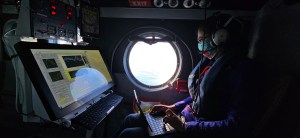This blog post originated in the 2015 Science Mission Directorate Technology Highlights Report (2 MB PDF).
Technology Development: A NASA-led team is designing an extremely compact origami rover for new extreme terrain applications in both the planetary and Earth science domains. PUFFERs (Pop-Up Flat Folding Explorer Robots) utilize a folding printed circuit board (PCB) as the rover chassis, which enables the platform to fold into a minuscule, palm-sized volume. With this feature, many PUFFERs can be integrated into future spacecraft or packed into Earth science experiments at low cost.
The multitude of PUFFERs would then be used to carry out science investigations that specifically require a distributed, multi-unit approach, such as entering cave formations on Mars or conducting spatially-distributed topographic mapping of ice on Earth. In addition to small packing volume, PUFFER’s folding chassis provides unique mobility benefits; PUFFERs can collapse into a lowprofile “crouch” to crawl beneath tight terrain features, such as overhung rocks, and to lower their center of gravity for ascending steep inclines. The highly-flexible origami-inspired chassis also provides impact-absorbing capabilities, allowing PUFFER to survive great falls.
Impact: The PUFFER technology will provide low-cost access to new science-rich terrains both on Earth and beyond. Here on Earth, scientists hope to deploy swarms of PUFFERs to track ice fluctuations in the polar regions. Teams of researchers could deploy PUFFERs over ice sheets of interest from the air, dropping the impact-resistant rovers from helicopters. The PUFFERs would then remain behind and autonomously rove over the ice while making measurements. The units would recharge themselves using solar energy, allowing them to operate for months and possibly years at a time. Work is currently underway to develop and test PUFFERs for snow and ice mobility, and the prototypes were recently tested at Mt. Erebus in Antarctica. Beyond our own planet, PUFFERs will provide future NASA missions with a low-cost add-on technology for accessing new extreme terrains. A swarm of PUFFERs could be folded up into a parent spacecraft, such as a larger rover or lander, and then be deployed into terrain features that the parent itself cannot reach. Example features of interest could include steep inclines and confined spaces, such as overhung rocks and caves on Mars, or “chaos terrains” on the surface of Europa.
Status and Future Plans: PUFFER has successfully completed initial field tests in both the Mojave Desert and Mt. Erebus in Antarctica. The Mojave Desert tests evaluated mobility on Mars-analog terrains, while the Antarctica testing evaluated snow and ice mobility. The team is currently preparing next-generation prototypes for expanded field tests, which will integrate new instruments such as cameras and a microscope.
Sponsoring Organization: The PUFFER technology is jointly funded by SMD’s Planetary Science and Earth Science Divisions, and by the Space Technology Mission Directorate (STMD) as part of the Game Changing Development (GCD) Program. In addition, the project’s small business partner, Distant Focus Corporation, has received funding through the NASA Small Business Innovation Research (SBIR) office for development of a novel folded optic microscope for PUFFER. The PUFFER effort is being led out of NASA Jet Propulsion Lab, with collaborators at the University of California, Berkeley; Distant Focus Corporation (Champaign, IL); and Pioneer Circuits Inc. (Santa Ana, CA).


































